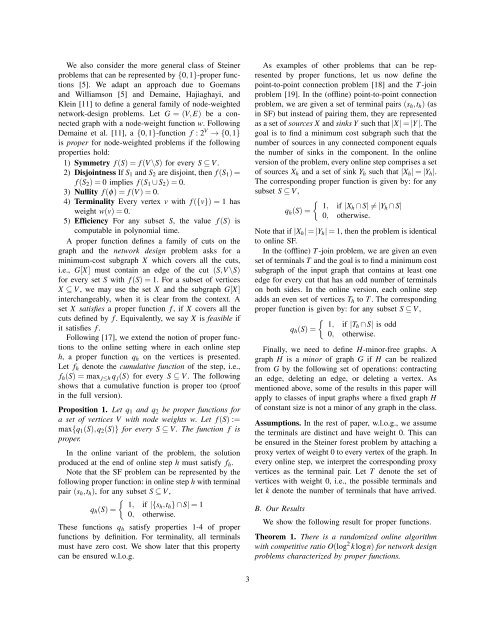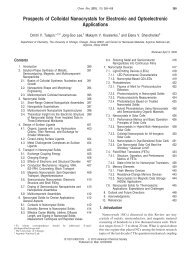Online Node-weighted Steiner Forest and ... - Duke University
Online Node-weighted Steiner Forest and ... - Duke University
Online Node-weighted Steiner Forest and ... - Duke University
Create successful ePaper yourself
Turn your PDF publications into a flip-book with our unique Google optimized e-Paper software.
We also consider the more general class of <strong>Steiner</strong><br />
problems that can be represented by {0,1}-proper functions<br />
[5]. We adapt an approach due to Goemans<br />
<strong>and</strong> Williamson [5] <strong>and</strong> Demaine, Hajiaghayi, <strong>and</strong><br />
Klein [11] to define a general family of node-<strong>weighted</strong><br />
network-design problems. Let G = (V,E) be a connected<br />
graph with a node-weight function w. Following<br />
Demaine et al. [11], a {0,1}-function f : 2 V → {0,1}<br />
is proper for node-<strong>weighted</strong> problems if the following<br />
properties hold:<br />
1) Symmetry f (S) = f (V \S) for every S ⊆ V .<br />
2) Disjointness If S 1 <strong>and</strong> S 2 are disjoint, then f (S 1 ) =<br />
f (S 2 ) = 0 implies f (S 1 ∪ S 2 ) = 0.<br />
3) Nullity f (φ) = f (V ) = 0.<br />
4) Terminality Every vertex v with f ({v}) = 1 has<br />
weight w(v) = 0.<br />
5) Efficiency For any subset S, the value f (S) is<br />
computable in polynomial time.<br />
A proper function defines a family of cuts on the<br />
graph <strong>and</strong> the network design problem asks for a<br />
minimum-cost subgraph X which covers all the cuts,<br />
i.e., G[X] must contain an edge of the cut (S,V \S)<br />
for every set S with f (S) = 1. For a subset of vertices<br />
X ⊆ V , we may use the set X <strong>and</strong> the subgraph G[X]<br />
interchangeably, when it is clear from the context. A<br />
set X satisfies a proper function f , if X covers all the<br />
cuts defined by f . Equivalently, we say X is feasible if<br />
it satisfies f .<br />
Following [17], we extend the notion of proper functions<br />
to the online setting where in each online step<br />
h, a proper function q h on the vertices is presented.<br />
Let f h denote the cumulative function of the step, i.e.,<br />
f h (S) = max j≤h q j (S) for every S ⊆ V . The following<br />
shows that a cumulative function is proper too (proof<br />
in the full version).<br />
Proposition 1. Let q 1 <strong>and</strong> q 2 be proper functions for<br />
a set of vertices V with node weights w. Let f (S) :=<br />
max{q 1 (S),q 2 (S)} for every S ⊆ V . The function f is<br />
proper.<br />
In the online variant of the problem, the solution<br />
produced at the end of online step h must satisfy f h .<br />
Note that the SF problem can be represented by the<br />
following proper function: in online step h with terminal<br />
pair (s h ,t h ), for any subset S ⊆ V ,<br />
{<br />
1, if |{sh ,t<br />
q h (S) =<br />
h } ∩ S| = 1<br />
0, otherwise.<br />
These functions q h satisfy properties 1-4 of proper<br />
functions by definition. For terminality, all terminals<br />
must have zero cost. We show later that this property<br />
can be ensured w.l.o.g.<br />
As examples of other problems that can be represented<br />
by proper functions, let us now define the<br />
point-to-point connection problem [18] <strong>and</strong> the T -join<br />
problem [19]. In the (offline) point-to-point connection<br />
problem, we are given a set of terminal pairs (s h ,t h ) (as<br />
in SF) but instead of pairing them, they are represented<br />
as a set of sources X <strong>and</strong> sinks Y such that |X| = |Y |. The<br />
goal is to find a minimum cost subgraph such that the<br />
number of sources in any connected component equals<br />
the number of sinks in the component. In the online<br />
version of the problem, every online step comprises a set<br />
of sources X h <strong>and</strong> a set of sink Y h such that |X h | = |Y h |.<br />
The corresponding proper function is given by: for any<br />
subset S ⊆ V ,<br />
{<br />
1, if |Xh ∩ S| ̸= |Y<br />
q h (S) =<br />
h ∩ S|<br />
0, otherwise.<br />
Note that if |X h | = |Y h | = 1, then the problem is identical<br />
to online SF.<br />
In the (offline) T -join problem, we are given an even<br />
set of terminals T <strong>and</strong> the goal is to find a minimum cost<br />
subgraph of the input graph that contains at least one<br />
edge for every cut that has an odd number of terminals<br />
on both sides. In the online version, each online step<br />
adds an even set of vertices T h to T . The corresponding<br />
proper function is given by: for any subset S ⊆ V ,<br />
{<br />
1, if |Th ∩ S| is odd<br />
q h (S) =<br />
0, otherwise.<br />
Finally, we need to define H-minor-free graphs. A<br />
graph H is a minor of graph G if H can be realized<br />
from G by the following set of operations: contracting<br />
an edge, deleting an edge, or deleting a vertex. As<br />
mentioned above, some of the results in this paper will<br />
apply to classes of input graphs where a fixed graph H<br />
of constant size is not a minor of any graph in the class.<br />
Assumptions. In the rest of paper, w.l.o.g., we assume<br />
the terminals are distinct <strong>and</strong> have weight 0. This can<br />
be ensured in the <strong>Steiner</strong> forest problem by attaching a<br />
proxy vertex of weight 0 to every vertex of the graph. In<br />
every online step, we interpret the corresponding proxy<br />
vertices as the terminal pair. Let T denote the set of<br />
vertices with weight 0, i.e., the possible terminals <strong>and</strong><br />
let k denote the number of terminals that have arrived.<br />
B. Our Results<br />
We show the following result for proper functions.<br />
Theorem 1. There is a r<strong>and</strong>omized online algorithm<br />
with competitive ratio O(log 2 k logn) for network design<br />
problems characterized by proper functions.<br />
3
















